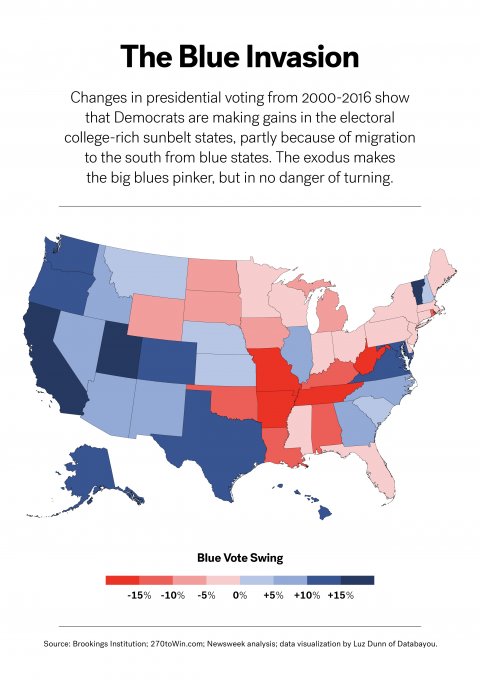Once upon a time, Virginia was reliably red. Now it's blue.
It's the same story for California, Oregon, Washington, Colorado, New Hampshire and New Mexico. Arizona, North Carolina and perhaps Georgia and Texas are on the way.
Republican Senator Kelly Loeffler is struggling in Georgia. Democrat Cal Cunningham is ahead in North Carolina in the U.S. Senate race. Polls show Democrat Jaime Harrison is in a dead heat with Republican Senator Lindsey Graham in reliably red South Carolina.
Within two presidential election cycles, much of the south will be blue. As former Georgia gubernatorial candidate Stacey Abrams told the New York Times: "The Sun Belt expansion (by Democrats) is what will drive the next thirty years of elections."
Demographers and political pros have been watching and discussing these trends for a decade. Now the data may finally be about to deliver results, starting in the fall. In other words: the Democrats long nightmare in the Sun Belt may be, at last, coming to an end

These states aren't turning blue because conservatives are suddenly discovering their inner AOC. The shift is driven by demographics—what demographers call "generational replacement," urbanization, and increasingly, the migration of blue state residents to red states. Worryingly for Republicans, these new arrivals have brought their voting habits and blue policies with them. Author Kristin B. Tate calls it the "liberal invasion of red state America." She believes that companies and people are fleeing high tax/low-growth blue states for low tax/high-growth red states. She says, "Harris County (Houston) where I live has absorbed a huge number of people from California. A middle-class family can afford a home here."
Welcome to the Great Migration 2.0, one that may give the Democrats an electoral advantage that could last for generations to come. (See map at end of story.)
To understand what's really going on, we spoke to a dozen experts and dove deep into the data. Working with data provided by William H. Frey, a senior fellow at the Brookings Institution and author of Diversity Explosion, we looked at twenty years of migration by state, and compared that to changes in presidential voting patterns using data from the website 270toWin. And finally, we studied migration patterns by age from a database at the University of Wisconsin.
What we found is not great news for the Grand Old Party.
OUT OF THE BLUE
We've used the difference in which candidate people voted for president in 2000 and 2016 to gauge whether a state is getting redder or bluer. Even though it's tempting to dismiss 2016 because the two candidates were particularly polarizing, 2016 was consistent with long term trends.
For example, Texas isn't blue, yet, but it's getting bluer. In 2000 President George W. Bush got 21 more percentage points in Texas than Senator Al Gore. In 2016, President Donald Trump beat Secretary Hillary Clinton by only 9 points. That means that the red advantage fell between 2000 and 2016. That's consistent with other recent election results in Texas, like Senator Ted Cruz squeaking by Beto O'Rourke in the closest Senate election in Texas since 1978.

Of course, migration cuts both ways. As blue voters leave that's helped turn states like Wisconsin, Pennsylvania and Michigan redder. Overall, 27 states turned redder and 23 plus the District of Columbia turned bluer since 2000. That sounds like good news for Republicans. But it's not. Swapping the Rust Belt for the Sun Belt is a bad deal for Republicans—46 votes from Pennsylvania, Wisconsin and Michigan for 109 (North Carolina, Georgia, Florida and Texas.)
Other states getting redder are already blood red already. And there aren't as many vulnerable blue states left to flip as there are red states that could potentially become blue.
Why is this happening? Simply put, it appears that residents from blue states are colonizing the red ones.
For those states that are getting bluer, a major factor is people moving into those states, specifically Arizona, Colorado and coastal southern states like North Carolina and even Georgia. Irwin Morris, William T. Kretzer Distinguished Professor of Humanities at North Carolina State University, says significant moves are mostly young people and are usually about economics. People are moving to southern states to find jobs. For example: Uber will bring some 3000 jobs to Dallas when it opens new facilities there. There's a good chance some of those employees will come from blue states. For these migrants, good weather is a bonus. They're taking over the places that have plenty of sunshine and (usually) great beaches: Arizona, Texas, North Carolina, South Carolina, and Georgia. It's a swarm to warm.
Those five states have added almost six million domestic migrants since 2000. That sounds like a lot. But Ken Johnson of University of New Hampshire says those net migration numbers may understate the churn in the electorate. We confirmed that using numbers provided by Brooking's Frey. Arizona's population is about 7.3 million. In 2018, 274,000 people moved in and 180,000 people moved out, for a gain of 94,000. That's only a 1 percent change in population, but it's a potentially much bigger turnover in the electorate. Here's an example: If the 180,000 who left were Republican voters and the 274,000 who moved in were all Democrats, that could mean a blue vote swing of 454,000 votes, five times as large as the net migration numbers would suggest.
Of course, that's an extreme and unlikely example—not everyone moving in or out is a voter, and it's likely both migrants are a mix of Republicans and Democrats. But it makes the point.
Professor Seth C. McKee, now at Oklahoma State, and Jeremy M. Teigen of Ramapo College have analyzed migration to the South and its impact on voting. Midwest migrants skewed slightly Democratic; those from the Pacific Coast very slightly Republican; and from the Mountain/Plains states strongly Republican. But the X-factors were those from the Northeast. They tended to overwhelmingly vote Democratic. How overwhelmingly? According to McKee and Teigen, "a 10 percent increase in newcomers from the Northeast to a southern county increases the Democratic presidential vote in 2008–2012 by approximately five percentage points." In the 2016 election, 11 states were decided by five points or less.

Their data says that overall for the South, in 2012 the mix of migrants was 34 percent from the Northeast, 31 percent from the Midwest, and 35 percent from the Mountains, Plains and Pacific Coast. Not surprisingly that varied widely across the region. Texas got only 40 percent of its migrants from the Northeast and the Midwest, while Georgia got 66 percent of their migrants from those regions, North Carolina 73 percent, South Carolina 75 percent, and Florida a whopping 81 percent.
Perhaps Republicans were right to worry about migrant caravans in 2018. But they were coming from New York.
CAROLINA BLUE
For a good case study of this trend, let's take a look at a state many political scientists see as the next red state to tip: North Carolina.
Today, it's a purple state, voting for Obama in 2008, for Romney in 2012 and Trump in 2016, who won 50 percent to 46 percent. That's a solid majority, but it's only a fraction of the 13 point advantage Bush had in 2000. J. Michael Bitzer, professor of politics and history at Catawba College in Salisbury, North Carolina, says, "The recent polls still have things pretty much a dead heat for both the presidential and U.S. Senate races."
The senate race is between incumbent Republican Thom Tillis and Democrat Cal Cunningham. In addition, polls show Democratic Governor Roy Cooper up by eight points over challenger Dan Forest.
As Newsweek's Jason Lemon reported, earlier this month the Asheville, N.C., City Council voted to pay reparations to African-Americans in what Mayor Esther Manheimer says is a "progressive leaning" city. "Asheville sure isn't the same as it used to be and I think those who have moved here over the last 20-40 years are at the core of that change," says Able Allen, who covers the City Council for the local newspaper, the Mountain Xpress.
Indeed, migration explains much of the change. Back when North Carolina was Senator Jesse Helms territory, it was a rural state composed of people who were born there. That's changed. According to Rebecca Tippett, founding director of Carolina demography at the Carolina Population Center at UNC-Chapel Hill, 70 percent of the state's population were native born in 1990. That's now down to 56 percent. McKee and Teigen analyzed the 2008 and 2012 presidential election results in North Carolina by voter tabulation district (the voting equivalent of a precinct) and found that the single most important factor in predicting voting outcome was migration. Between 2000 and 2016, North Carolina added a million newcomers. In 2018, 62 percent of the domestic migrants came from blue states, mostly in the northeast.
Of course, not everyone from a blue state votes blue. Many older people lean red and North Carolina is a destination for retirees from the snowbelt. In the 2000's, the median age of migrants to Florida and South Carolina has been 10 to 15 years older than those to Virginia and Georgia. North Carolina's migrants fall in-between—older than blue Virginia's, but younger than red South Carolina's. Retirees who relocate to North Carolina tend to settle either in the mountains or along the coast. They often move to rural areas, but not necessarily farm counties. Rather they're more likely to move to what University of New Hampshire professor Kenneth Johnson calls "recreational" counties.

But they're outnumbered by younger people who move to North Carolina urban areas for job opportunities. Many are mid-career professionals and new graduates attracted to the Triangle (the Research Triangle Park area, which includes Raleigh, Durham and Chapel Hill) or the massive banking industry in Charlotte. As Brookings' Frey says, "Big cities are magnets. You can still get your latte and New York Times." Together the two streams of migrants create jobs that attract more domestic migrants, like those who work in industries like construction and services, including many Hispanics.
For those hoping to keep North Carolina red, that growing Hispanic population may be the most worrying trend. According to the Carolina Population Center, between 2010 and 2018, the U.S. Census Bureau estimates that North Carolina's Hispanic population grew by 197,000 new residents. Today many Hispanic migrants either lack citizenship or are too young to vote, but both of those could change. "The electorate lags demographics. It takes time for changes to show up in the voting," says Tippett.
Lag or no lag, the change is here in North Carolina: In addition to migration and the growing Hispanic population, there's also generational change. Tippett has prepared a forecast of North Carolina demographics through 2035. Her analysis says that millennials already outnumber boomers in the state, and by 2035 there will be three times as many millennials and Gen Xers as boomers. Even the Gen Z cohort will be larger than boomers.
Unless there's a seismic shift in how migrants, minorities, and young people vote, North Carolina is going blue.
MEANWHILE...IN TEXAS
Migration is also having an impact in other battleground states like Texas and Georgia.
In Texas, it's conservatives from the Mountain and Plains states versus Democratic-voting Hispanics and migrants from the Northeast and Midwest. According to projections by the state of Texas, within the next few years Hispanics will become the largest single ethnic group. That's fueled by migration. Non-Hispanic whites will drop from 45 percent of the population to 28 percent by 2050. In Georgia, according to the Governor's Office of Planning and Budget, non-Hispanic whites will be less than half of the population in a decade (although they will still be a plurality.) Some of that is caused by reverse migration, descendants of African-Americans who moved north looking for opportunities and fleeing persecution during the Great Migration of the 20th Century. Sabrina Pendergrass, assistant professor of African American Studies at the University of Virginia, says Atlanta has more African-American newcomers than any other city. Political scientists believe the combination of millennials, African-Americans and Hispanics is a toxic mix for Republicans.
Conservative author Tate has her fingers crossed that the young blue millennials moving to red states may grow out of voting for Democrats as they buy homes and get property tax bills. Bitzer laughs, "I haven't seen a shred of research that says millennials are changing their politics as they get older."
BOTTOM LINE
Most experts agree North Carolina, Georgia and perhaps Florida, Arizona and Texas will turn blue, but no one is sure exactly when. NCSU's Morris says "The vector is clear but the timing is not. Usually there's a decrease in migration during an economic downturn. And there's COVID. But while the rate of migration may decrease, don't expect to see any changes in the demographic mix of movers."
Here's what is clear: We're likely to see the blue wave crest in the national and statewide races first. State assemblies and the House of Representatives can be tilted by redistricting, which is done by state legislatures. Despite being less than half the population, Republicans control 58 percent of those, according to the National Conference of State Legislatures, and not surprisingly they draw maps that favor them. In 2018, the Supreme Court split along partisan lines in upholding most of the 2013 redistricting in Texas, although it did find one district was the result of racial gerrymandering. North Carolina redistricted following the 2010 elections after Republicans won a supermajority in both houses of the General Assembly. They have redistricted twice since, all of which have been challenged in the courts. According to Bloomberg, the court-ordered plan finalized at the end of 2019 is expected to give Democrats a "strong chance" to add two House seats.
Distinguished Professor Charles S. Bullock III, who holds the Richard B. Russell Chair of Political Science at the University of Georgia, says, "Republicans are dying off and their grandchildren are voting Democratic. The Democrats are making gains in Georgia, Florida and North Carolina. Republicans are starting to lose at the state level. Congressional districts are flipping. (Brian) Kemp won in Georgia by a fourth of what Trump won by. And had there been an honest count in North Carolina, that congressional seat might have flipped. The new South is going to turn blue in 2020's and Democrats will consolidate their gains in the 2030's."
He adds: "It took a long time to go from being solid blue to solid red, and once it goes blue, it's going take a long time to go back."

DATA DON'T LIE
It's tempting to look at the 2020 election as a test of the red-states-turning-blue theory. Probably not. This very polarizing president, a historically weak economy and the pandemic create a unique and unpredictable situation. No one knows how these factors will affect turnout, which way independent voters will go or whether something else will happen before then that will change the equation yet again. Texas, North Carolina, Arizona, Georgia and Florida could go red or blue, and pundits could offer a plausible narrative to explain either outcome. Real Clear Politics says the most recent Fox News poll (as of June 25) shows Biden up in all five states, but it's five months between that finding and the first Tuesday in November.
Nonetheless, the data don't lie. Change is coming. The Blue states are colonizing the big, electoral college rich Red states—and there's little those Red states, and the GOP, can do about it.
Sam Hill is a frequent contributor to Newsweek and an eleventh generation Southerner. Hank Gilman is a Newsweek editor and columnist. Giacomo Eisler from Indiana University and Luz Dunn, who runs the website Databayou, also contributed to this article.














